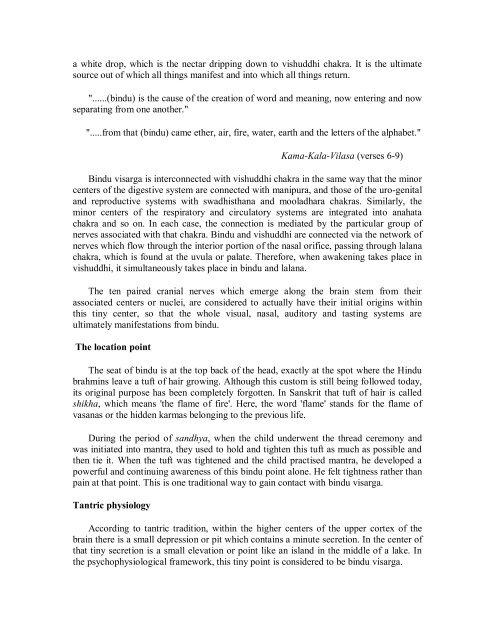Kundalini.Tantra.by.Satyananda.Saraswati
Create successful ePaper yourself
Turn your PDF publications into a flip-book with our unique Google optimized e-Paper software.
a white drop, which is the nectar dripping down to vishuddhi chakra. It is the ultimate<br />
source out of which all things manifest and into which all things return.<br />
"......(bindu) is the cause of the creation of word and meaning, now entering and now<br />
separating from one another."<br />
".....from that (bindu) came ether, air, fire, water, earth and the letters of the alphabet."<br />
Kama-Kala-Vilasa (verses 6-9)<br />
Bindu visarga is interconnected with vishuddhi chakra in the same way that the minor<br />
centers of the digestive system are connected with manipura, and those of the uro-genital<br />
and reproductive systems with swadhisthana and mooladhara chakras. Similarly, the<br />
minor centers of the respiratory and circulatory systems are integrated into anahata<br />
chakra and so on. In each case, the connection is mediated <strong>by</strong> the particular group of<br />
nerves associated with that chakra. Bindu and vishuddhi are connected via the network of<br />
nerves which flow through the interior portion of the nasal orifice, passing through lalana<br />
chakra, which is found at the uvula or palate. Therefore, when awakening takes place in<br />
vishuddhi, it simultaneously takes place in bindu and lalana.<br />
The ten paired cranial nerves which emerge along the brain stem from their<br />
associated centers or nuclei, are considered to actually have their initial origins within<br />
this tiny center, so that the whole visual, nasal, auditory and tasting systems are<br />
ultimately manifestations from bindu.<br />
The location point<br />
The seat of bindu is at the top back of the head, exactly at the spot where the Hindu<br />
brahmins leave a tuft of hair growing. Although this custom is still being followed today,<br />
its original purpose has been completely forgotten. In Sanskrit that tuft of hair is called<br />
shikha, which means 'the flame of fire'. Here, the word 'flame' stands for the flame of<br />
vasanas or the hidden karmas belonging to the previous life.<br />
During the period of sandhya, when the child underwent the thread ceremony and<br />
was initiated into mantra, they used to hold and tighten this tuft as much as possible and<br />
then tie it. When the tuft was tightened and the child practised mantra, he developed a<br />
powerful and continuing awareness of this bindu point alone. He felt tightness rather than<br />
pain at that point. This is one traditional way to gain contact with bindu visarga.<br />
Tantric physiology<br />
According to tantric tradition, within the higher centers of the upper cortex of the<br />
brain there is a small depression or pit which contains a minute secretion. In the center of<br />
that tiny secretion is a small elevation or point like an island in the middle of a lake. In<br />
the psychophysiological framework, this tiny point is considered to be bindu visarga.














![[Lonely Planet] Sri Lanka](https://img.yumpu.com/59845622/1/169x260/lonely-planet-sri-lanka.jpg?quality=85)


